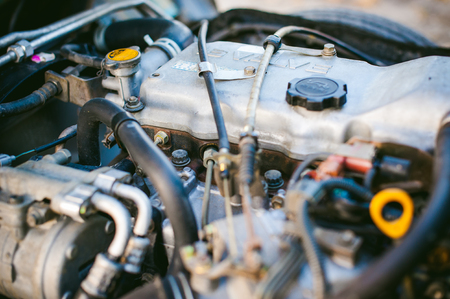1. Introduction to Brake Fluid
Brake fluid is a crucial component of a vehicle’s braking system, playing a vital role in ensuring your car stops smoothly and safely. Without it, your brakes wouldn’t function properly, making driving extremely dangerous.
What Is Brake Fluid?
Brake fluid is a hydraulic fluid that transfers force from the brake pedal to the braking mechanisms at each wheel. It operates under high temperatures and pressure, enabling the braking system to function efficiently.
How Does Brake Fluid Work?
When you press the brake pedal, brake fluid transmits that force through the brake lines to engage the brake pads or shoes, creating friction to slow down or stop the vehicle. Since brake fluid is non-compressible, it ensures a rapid and efficient transfer of force.
Types of Brake Fluid
There are different types of brake fluid, categorized based on their composition and boiling points. Choosing the right type for your vehicle is essential for optimal performance.
| Brake Fluid Type | Base Composition | Common Use |
|---|---|---|
| DOT 3 | Glycol-based | Most passenger vehicles |
| DOT 4 | Glycol-based | Performance and heavy-duty vehicles |
| DOT 5 | Silicone-based | Classic and military vehicles |
| DOT 5.1 | Glycol-based | High-performance and ABS-equipped vehicles |
Why Is Brake Fluid Important?
Brake fluid not only ensures that your vehicle stops properly but also prevents corrosion within the brake system. Over time, brake fluid absorbs moisture, which can reduce braking efficiency and cause internal rust. Regular maintenance is key to vehicle safety and performance.
2. Why Brake Fluid Is Crucial
Brake fluid plays a critical role in ensuring your vehicle’s braking system works efficiently and safely. Without it, your car wouldn’t be able to stop properly, leading to dangerous driving conditions. Let’s break down why brake fluid is so important.
How Brake Fluid Enables Braking
When you press the brake pedal, you’re not directly stopping the wheels. Instead, you’re initiating a hydraulic process that relies on brake fluid to transfer force from the pedal to the brake components. Here’s how it works:
| Step | What Happens |
|---|---|
| 1. Pressing the Brake Pedal | You push the pedal, which activates the master cylinder. |
| 2. Fluid Transfers Force | Brake fluid moves through the brake lines, transmitting the force. |
| 3. Brakes Engage | Calipers or wheel cylinders apply pressure to the brake pads or shoes. |
| 4. Vehicle Slows or Stops | The friction from pads or shoes against the rotors or drums slows the car. |
Key Properties of Brake Fluid
Brake fluid isn’t just regular liquid—it has special properties that make it effective in stopping your car:
- Non-Compressible: Brake fluid must not compress under pressure, ensuring immediate brake response.
- High Boiling Point: Brakes generate a lot of heat; a high boiling point prevents fluid from vaporizing and losing effectiveness.
- Anti-Corrosion: Brake fluid prevents internal corrosion within the brake lines and components.
- Water Absorption: It absorbs moisture to help minimize the risk of water buildup, which can compromise braking performance.
What Happens If Brake Fluid Fails?
Brake fluid can degrade over time due to moisture absorption and heat exposure. If it’s old or contaminated, your brakes may feel soft, spongy, or even fail. Some signs of brake fluid failure include:
- Soft or unresponsive brake pedal
- Longer stopping distances
- Brake warning light on the dashboard
- Dark or dirty-looking brake fluid
Conclusion
Maintaining proper brake fluid levels and quality is essential for safe and efficient braking. Understanding how brake fluid works and ensuring it remains in good condition will help keep your vehicle’s braking system functioning correctly.
![]()
3. Types of Brake Fluid
Brake fluid comes in several types, each with its own chemical composition and performance characteristics. Choosing the right brake fluid for your vehicle is essential for optimal braking performance and safety. Below, we break down the most common types of brake fluid and their uses.
DOT 3 Brake Fluid
DOT 3 is one of the most commonly used brake fluids in passenger vehicles. It is glycol-based and absorbs moisture over time, which can lower its boiling point and affect braking performance.
Key Features:
- Glycol-based
- Boiling point: Around 401°F (205°C) dry, 284°F (140°C) wet
- Tends to absorb moisture from the air
- Compatible with most standard braking systems
DOT 4 Brake Fluid
Similar to DOT 3, DOT 4 is also glycol-based but has a higher boiling point, making it suitable for high-performance or heavy-duty vehicles.
Key Features:
- Glycol-based with additives for better moisture resistance
- Boiling point: Around 446°F (230°C) dry, 311°F (155°C) wet
- Used in many modern cars with ABS and higher braking demands
- Absorbs moisture over time
DOT 5 Brake Fluid
DOT 5 is a silicone-based brake fluid that does not absorb moisture, giving it a longer service life. However, it is not compatible with systems designed for glycol-based fluids.
Key Features:
- Silicone-based (not hygroscopic)
- Boiling point: Around 500°F (260°C) dry and wet
- Does not mix with DOT 3 or DOT 4
- Commonly used in classic cars, military vehicles, and motorcycles
DOT 5.1 Brake Fluid
Despite its similar name, DOT 5.1 is glycol-based like DOT 3 and DOT 4, but with a boiling point close to that of DOT 5. It is often used in performance and heavy-duty applications.
Key Features:
- Glycol-based (hygroscopic)
- Boiling point: Around 518°F (270°C) dry, 374°F (190°C) wet
- Suitable for high-performance vehicles
- Compatible with DOT 3 and DOT 4
Comparison of Brake Fluids
| Brake Fluid Type | Base Composition | Dry Boiling Point | Wet Boiling Point | Hygroscopic? | Common Applications |
|---|---|---|---|---|---|
| DOT 3 | Glycol-based | 401°F (205°C) | 284°F (140°C) | Yes | Standard passenger vehicles |
| DOT 4 | Glycol-based | 446°F (230°C) | 311°F (155°C) | Yes | ABS-equipped cars, performance vehicles |
| DOT 5 | Silicone-based | 500°F (260°C) | 500°F (260°C) | No | Classic cars, military use |
| DOT 5.1 | Glycol-based | 518°F (270°C) | 374°F (190°C) | Yes | Performance and heavy-duty vehicles |
Understanding the differences between these brake fluids can help ensure youre using the right one for your vehicle. Always refer to your owners manual to see which type is recommended for your specific braking system.
4. Signs of Brake Fluid Problems
Your vehicle’s brake fluid plays a crucial role in ensuring safe and responsive braking. However, over time, brake fluid can degrade or develop issues that compromise braking performance. Here are some key symptoms that may indicate a problem with your brake fluid.
Soft or Spongy Brake Pedal
One of the most noticeable signs of brake fluid trouble is a soft or spongy brake pedal. If your brake pedal feels mushy or sinks to the floor with little resistance, it may indicate air or moisture in the brake fluid, reducing its effectiveness.
Discolored or Dirty Brake Fluid
Healthy brake fluid is usually clear to light amber in color. Over time, exposure to heat and contaminants can cause it to darken, turning brown or even black. Dirty brake fluid reduces braking efficiency and signals the need for a fluid flush.
Warning Light on Dashboard
Many modern cars have a brake warning light that may illuminate if there is an issue with the brake fluid, such as low levels or contamination. If this light comes on, it’s important to check your brake fluid and address any potential issues promptly.
Reduced Braking Performance
If you notice that your brakes are not as responsive as they used to be, you may be dealing with brake fluid problems. Reduced stopping power or needing more pressure to bring your vehicle to a halt could indicate degraded or low brake fluid levels.
Burning Smell After Heavy Braking
A strong burning odor after applying the brakes forcefully may indicate overheated or contaminated brake fluid. This can lead to brake fade, where the braking system temporarily loses its effectiveness, posing a safety risk.
Common Brake Fluid Issues and Their Symptoms
| Brake Fluid Issue | Common Symptoms |
|---|---|
| Air in Brake Lines | Soft or spongy brake pedal |
| Moisture Contamination | Reduced braking performance, corrosion in braking system |
| Old or Dirty Brake Fluid | Dark-colored fluid, sluggish brake response |
| Low Brake Fluid Level | Brake warning light, weak braking |
| Overheated Brake Fluid | Burning smell, brake fade |
Recognizing these signs early can help you address brake fluid problems before they lead to serious safety hazards. Regular brake fluid checks and maintenance are essential to keeping your braking system in optimal condition.
5. How to Maintain and Replace Brake Fluid
Best Practices for Checking, Maintaining, and Flushing Brake Fluid
Proper brake fluid maintenance is essential for ensuring your vehicles braking system works efficiently. Over time, brake fluid can absorb moisture, leading to reduced performance and potential brake failure. Follow these best practices to keep your braking system in top shape.
1. Checking Brake Fluid
Regularly inspecting your brake fluid level and condition helps prevent issues before they become serious. Here’s a simple guide:
| Step | Action |
|---|---|
| Locate the Reservoir | Find the brake fluid reservoir under the hood, usually near the back of the engine bay. |
| Check Fluid Level | The reservoir has “MIN” and “MAX” markings. Ensure the level is between these marks. |
| Inspect Fluid Condition | Fresh brake fluid is light amber or clear. If it appears dark or contaminated, it needs replacement. |
2. Maintaining Brake Fluid
Keeping brake fluid in good condition reduces wear and prevents brake system issues. Follow these tips:
- Use the correct brake fluid type specified in your owner’s manual.
- Ensure the brake fluid reservoir cap is always tightly sealed to prevent moisture contamination.
- Avoid mixing different brake fluid types, as this can reduce performance.
3. Flushing and Replacing Brake Fluid
Brake fluid should be replaced periodically to maintain optimal performance. Many manufacturers recommend flushing the system every 2 to 3 years.
Step-by-Step Brake Fluid Flush
- Jack up the vehicle and remove the wheels for better access to the brake system.
- Locate the brake bleeder valves on each wheel.
- Attach a clear plastic tube to the bleeder valve and place the other end in a container.
- Have someone press the brake pedal while you open the bleeder valve to allow the old fluid to drain.
- Add fresh brake fluid to the reservoir as the old fluid drains to prevent air from entering the system.
- Repeat this process for each wheel until fresh fluid flows from the bleeder valve.
- Securely tighten the bleeder valves and check the fluid level before replacing the wheels.
Regularly checking, maintaining, and replacing brake fluid helps keep your braking system responsive and reliable, ensuring your safety on the road.

